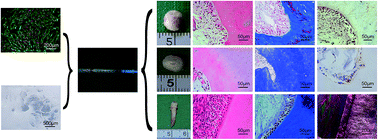Regeneration of dentin–pulp-like tissue using an injectable tissue engineering technique
Abstract
An injectable tissue engineering method was developed for dentin–pulp complex regeneration using an injectable scaffold, crosslinked hyaluronic acid gel (HAG). A cell–scaffold composite composed of HAG, tooth bud-derived dental mesenchymal cells (DMCs), and transforming growth factor-β1 (TGF-β1) was prepared and injected subcutaneously into nude mice. Moreover, β-tricalcium phosphate (β-TCP) and polyglycolic acid (PGA) were chosen as control scaffolds for dentin–pulp regeneration. The suitability of injectable HAG for dentin–pulp complex engineering was further demonstrated in empty tooth slices and the pulp chambers of mini pigs. Histological and immunohistochemical staining was carried out to identify the distinctive tubular dentin and pulp structure, which was further confirmed by the detection of several dentinogenesis-related genes, DSPP, DMP-1, MEPE, and BSP. It was found that a recognizable dentin–pulp-like tissue with a typical well-organized dentinal tubular structure, columnar odontoblast-like cells, was successfully engineered using the injectable HAG scaffold within the subcutaneous area of nude mice, according to histological staining. High expression of the genes DSPP, DMP-1, MEPE and BSP in the above neo-tissue as well as positive immunohistochemical staining for dentin sialoprotein (DSP) confirmed the dentinal characteristics. No typical dentin- or pulp-like tissue was formed when PGA or β-TCP were used as scaffolds. The efficacy of this method was further demonstrated in empty tooth slices and pulp chambers of mini pigs that had been pretreated by the removal of total pulp and partial dentin. Through the successful delivery of DMCs and TGF-β1 by the injectable HAG scaffold, the destroyed dentin was vividly repaired along with the formation of pulp-like tissue. Hence the current strategy to engineer dentin–pulp complex can overcome the difficulty of specific anatomical arrangement of pulp and dentin with minimal invasion, finally leading to regained vitality, which is difficult to realize by the current clinical treatments.


 Please wait while we load your content...
Please wait while we load your content...